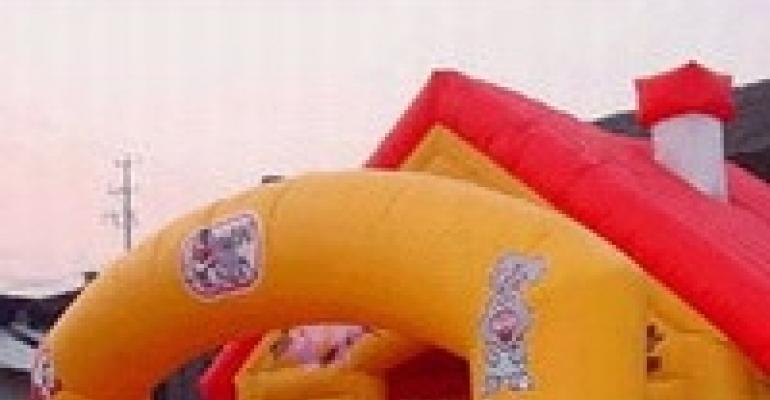
The inflatables industry is in the hot seat after an Arizona girl received a concussion last week when what her family described as a "microburst" of wind blew the bounce house she and a friend were playing in onto the roof of a house 100 feet away.
Some in the industry question why the bounce operator allowed the unit to operate that day when the day prior, the National Weather Service predicted winds in the area of 15 to 25 mph with gusts up to 40 mph.
“Under no circumstances should an inflatable be set up when the wind speed is over 15 mph," Michael Solaimani, owner of Jump for Joy Moonwalks of Richmond, Va., tells Special Events."In an inflatable with a covered roof, the air temperature can be warmer inside than it is outside the inflatable," Solaimani explains. "When a burst of cold air is blown in, you get a 'hot air balloon' effect. This will give an inflatable an instant lift if there is enough temperature difference between the outside and inside air temperatures. These are all things that we take into consideration when we purchase our inflatables as well as when we are setting them up.”
SAFER STAKES
Geoff Wiley, manager of Bellevue, Wash.-based Better Bouncers, stands up for responsible inflatables operators.
Five years ago, inflatables stakes were only 18 inches long, but "now we use 3½-foot stakes," Wiley says. He regards the "microburst" incident as a freak occurrence, noting that even the new, longer stakes can't hold down a bounce house in winds "strong enough to uproot an 80-foot tree." Instead, he points to supervision as the key to safety. While Washington state won't allow inflatables to operate when winds hit 25 mph, Wiley's firm draws the line at 20 mph.
SHODDY SHORTCUTS
Established operators express frustration at competitors who compete on price while failing to meet insurance and safety standards.
“I do strongly feel something needs to be done to stop the people coming into this industry that do not have insurance and have not had the proper training that is necessary to operate an inflatable business," Solaimani says. "It's these individuals that are hurting our industry and driving our profits into the ground.”
And shoddy performance by some inflatables operators not only hurts that segment of the industry, but the event planners who hire them as well.
'IT CANNOT HAPPEN TO ME'
David Peters, head of Orlando, Fla.-based Absolute Amusements, is a veteran of the amusements business and was once a partner in the largest inflatable manufacturer in the U.S.
"I have spoken with literally thousands of event planners that think, 'It cannot happen to me,'" Peters says. "I urge all planners to do their homework, visit the inflatable rental company in person, review the insurance with an insurance professional, and to also get insurance themselves. I have seen planners lose ten years’ worth of earnings, sometime more, in a single moment when found guilty of negligence for not taking these simple precautions."
He adds, "These are the stories nobody wishes to talk about, the stories that get sealed in a judgment with a gag order--the stories that are too embarrassing for planners to tell."SAFETY TIPS FOR SAFE INFLATABLES
Creative Operational Concepts, with offices in Nashville, Tenn., Henderson, Nev., and East Longmeadow, Mass., provides staff training for inflatables suppliers as well as other amusements. Cindee Huddy, chief operating officer and co-founder, offers these safety tips:
- Inflatables for individual residential use should be properly anchored; ground anchors provided by the manufacturer should always be used.
- Additional weights such as sandbags with the appropriate weight can also be used in conjunction with the anchors.
- Tie downs and anchors are best suited every 5 feet on an inflatable for security purposes.
- Individuals should always follow the manufacturer guidelines for set-up and operation.
- When in use, all inflatables should have a designated attendant supervising the children. This individual should be at the inflatable at all times and not just in the general vicinity.
- Always follow the manufacturer's guidelines with regard to weather. Inflatables should not be operated on days with a sustainable wind.
RELATED STORIES FROM SPECIAL EVENTS
Inflatable Amusements Face Tough New Regulations and an Insurance Crisis
Renters of Inflatable Amusements are Taking Safety More Seriously, Investing in Training





